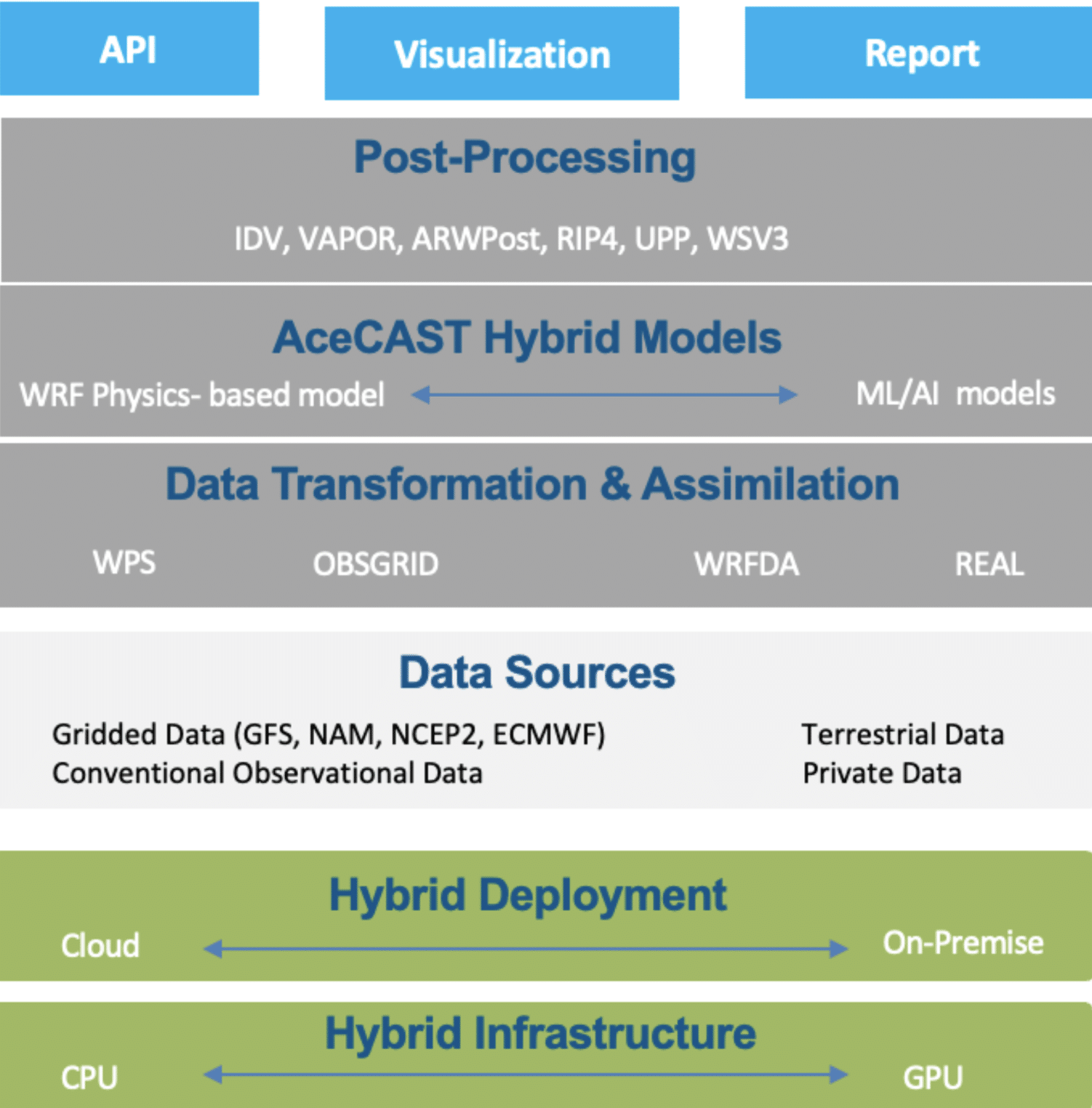Hybrid Weather Twin™
Blending Accelerated Physics-based with Machine Learning/Artificial Intelligence Weather Forecast Models for Better/Faster/Cheaper Forecasts
By: Christian Tanasescu, COO & CTO, TempoQuest
Numerical weather prediction is increasingly proving its value in saving lives and protecting property in societies particularly vulnerable to extreme weather events. These extremes become more intense under the influence of climate change, making it ever more important for better numerical weather prediction. One way to enhance the skill of numerical weather prediction is to augment the physics-based algorithms and models with the power of Machine Learning (ML) and Artificial Intelligence (AI) models nurtured by the myriad connected sensor measurements (satellites, radar, lidar, radiometers, etc.) driven by in-situ, remote sensing, and Internet of Things (IoT).
The term Digital Twin is being used to refer to the digital replica of a system or physical assets, derived from real-life data collected using various types of sensors and monitoring technologies of the asset while in operation. It often means that an analytical data-driven model (i.e. the twin) is built to analyze, update, predict, and/or manage the operation at performance of its physical counterpart.
ML and AI give predictions based on the past and automate reasoning trained on historical data. It works nicely for nowcasting, however with comprehensive, incremental, and multifaceted retraining, it becomes possible to predict the future with quantifiable certainty.
Weather systems are highly nonlinear meaning that a small change now can lead to incredibly large changes in the future. A nonlinear system isn’t random, but the behavior of the system can be difficult to predict. Forecasts for medium – and long-term, in particular, climate change, rely on the first principles of physics laws. Only physics-based modeling and algorithms can predict new cause-effect relationships when there is little data available to initialize the forecast model and when new initial conditions can appear.
TQI’s aim is to expand from accelerated physics-based forecasting to augmented forecasting bypassing the required time-consuming calculations using physics-based algorithms. This means adding predictive models generated by ML and deep learning (DL) to replicate physics laws encoded in AceCAST. TQI has adopted a novel approach called Hybrid Weather Twin (HWT) for all its products and services that is the combination of physics-based and data-driven modeling for decision-making. The former builds cause and effect relationships to explore the possibility of future events, based on theoretical descriptions and variations of the initial conditions while the latter updates the hybrid model with the real observations. TQI’s HWT harnesses the benefits of both speed and performance with the blending of a digital twin counterpart with the accelerated physics-based predictive model and the modern-day ML/DL-based off-loaded training model that fully leverages the available contemporary weather data analytic technology.
Figure 1 below describes the conceptual architecture of HWT. One distinctive feature is that “hybrid” applies at different levels:
- Compute node: CPU and GPU
- Deployment: on-premise, on-demand private and public cloud
- Data sources: gridded data, observational data, private data
- Assimilation/Forecast Models: physics-based and ML/AI

TQI will use ML/DL methods at several levels. First, at the preprocessing level to improve data thinning, enhancement, and assimilation. By automatically locating high-impact events, we can preferentially use that data in the assimilation process. Second, replacing computational expensive first principles routines with surrogate models built with ML/DL. Third, in post-processing, automatically detecting the most important variables, patterns, and outliers.
This HWT approach relies on the combination and complementarity of theory-based models and ML/DL-driven models and is more powerful and efficient when both types of models run on the same GPU platform. With the AceCAST weather forecast software, both partial differential equation solver and ML/DL run on GPU, enabling fast, hyperlocal custom forecasts.
AceCAST’s (the physics-based component of HWT) higher resolution directly enhances the ability of models to simulate small-scale extreme events, and enables the information in observations to be better assimilated at the initial time. In doing so, this reduces the dependence of models on inaccurate parameterized processes, which reduces the systematic errors.
HWT incorporates ML and DL to automatically and continually improve its dynamic models, reduce local biases of scientific simulations and accelerate information delivery.
As a shortcut, physics-based models define the Virtual Twin and ML/DL models the Digital Twin. The Hybrid Weather Twin is the blend of the two and offers an untapped opportunity to improve the skills of weather and climate predictions at a new level of accuracy.
HWT is TQI’s innovative platform for providing better/faster/cheaper weather forecast intelligence and for building decision-making systems to manage the weather and climate impact on the economy.
Follow TempoQuest on our LinkedIn, Facebook, and Twitter accounts for additional updates. We look forward to continuing to share our latest news and collaborations with you.
TempoQuest LinkedIn: https://www.linkedin.com/company/tempoquest-inc
TempoQuest Facebook: https://www.facebook.com/TempoQuestInc
TempoQuest Twitter: https://twitter.com/tempoquest_inc

